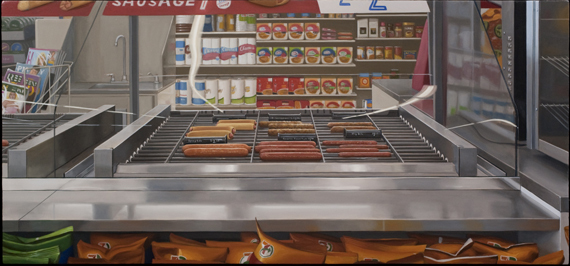We're coming up on one of my favorite times of the year: that time, just after spring breaks out but before summer begins, in which thousands of college graduates are released into the world. And as they go forth we give them advice, lots of advice. The advice varies, sometimes conflicts, but the general idea is: Here is what you need to know in order to succeed in the world. I've given a few of these speeches myself. Indeed,
Thrive grew out of
a commencement speech I gave last year at Smith College.
This year my book tour is taking me to a lot of colleges, and my first piece of advice is to start by defining success for yourself -- by being clear about what you want, what you value and what you are about. But before we can do that, we need to clear away the noise of the world to be able to truly listen to ourselves. And to do that, we need to abandon, or at least mitigate, some of the worst practices of the adult world that students are already mired in: burnout, sleep deprivation, stress and anxiety. And from that place of greater wisdom and perspective, graduates will be infinitely more effective at all the things they want to master: overcoming fears, taking risks, improving confidence, networking effectively, getting the job they want, getting a higher salary, etc.
This is all the more important because this generation is starting out their adult lives burdened with multiple deficits. To take the most obvious one, the total amount of student loan debt is now
$1.2 trillion (
greater than the total amount of credit card debt).
Graduating with this kind of burden would be overwhelming even if today's graduates were entering a robust job market, but of course they are not. Indeed, the effective unemployment rate (which factors in those who have given up looking for jobs) for those aged 18 to 29 is
nearly 16 percent. For African Americans in that age bracket, it's nearly 24 percent.
It's no wonder that
14 percent of 24- to 34-year-olds are still living with their parents. It's not just because they can't find a job; half of those living with Mom and Dad are employed full-time.
Of course, thriving is about
more than just financial and professional success. And there are few signposts for those in college encouraging a culture of well-being and taking care of our human capital.
Among those 18 to 29 years old,
nearly half don't get the amount of sleep they need. We know that lack of sleep increases stress, but then stress also makes it hard to sleep. And according to the
Journal of Adolescent Health, stress keeps
68 percent of students up at night.
"I sleep only three hours a night, and I can't keep doing it," a student told me at the Harvard School of Public Health last week. "And you are telling me something I had known all along: that it is OK to sleep, that it is OK to give time for the little things in life."
It's a vicious cycle that has made millennials our most stressed demographic,
according to the American Psychological Association. And nearly 40 percent of millennials reported their stress increasing in the year before this 2012 study. But only
17 percent said they get "a lot or a great deal" of help in dealing with their stress.
We hear a lot about the dangers of binge drinking on campus (and rightly so), but much less about the effects of stress and sleep deprivation among students -- including the connection between stress and binge drinking and depression. But the evidence is all too visible. Today
44 percent of American college students say they've had symptoms of depression. And a 2011 study from the American College Health Association
found that around 30 percent felt "so depressed that it was difficult to function" at some point in the previous year.
And the trend line is going in the wrong direction. According to a study in the journal
Professional Psychology: Research and Practice, the number of college students suffering from depression
doubled between 1988 and 2003. Screening for Mental Health
found that from 2005 to 2010, depression grew in 18- to 25-year-olds by 17 percent.
Even worse, the likelihood of suicidal thoughts
tripled from 1988 to 2003. In fact, we lose
more than 1,000 college students to suicide every year, making suicide the
second leading cause of death among college students, after accidents (including car accidents and drug overdoses).
These numbers reflect a wider, and very troubling, phenomenon in our culture. Since 1988 the use of antidepressants has gone up
almost 400 percent, and they are now the most frequently taken drug by those 18 to 44 years old. More troubling is that between 1993 and 2005 the use of prescription stimulants such as Ritalin and Adderall went up
93 percent among college students, while the use of prescription opioids like Vicodin and Oxycontin jumped a staggering 343 percent.
As any parent knows, what our children see us do has a much bigger impact on them than what we tell them to do. So if the lesson we're teaching them by how we live is that burnout, stress and sleep deprivation are the highway to success -- consequences be damned -- it appears that our college students are dutifully, and dangerously, following in our footsteps.
The good news is that the changes we are seeing in our workplaces -- adopting meditation, yoga and other stress-reduction practices -- are also beginning to be introduced into college life. According to a 2013 study by Robert Youmans of George Mason University and Jared Ramsberg, a graduate student at the University of Illinois, the side-effect-free way to get better grades is to meditate. Testing a random grouping of students, they
found that students who meditated before a lecture scored higher on a quiz afterward than those who didn't.
Youmans, a practicing Buddhist, makes it clear that other forms of quiet and contemplation are as effective as meditation. "Basically," he says, "becoming just a little bit more mindful about yourself and your place in the world might have a very important, practical benefit -- in this case, doing better in college."
A study by researchers at the University of California at Santa Barbara
found that a two-week mindfulness training course boosted the working memory of students enough to translate into a 16-percent increase on the GRE (the standardized test required for most graduate schools). "We found reduced mind-wandering in every way we measured it and improved performance on both reading comprehension and working memory capacity," said professor Michael Mrazek. The researchers are now extending the studies to K-12 students.
In fact, Andrew Jones, a sociology teacher in the UK,
wrote in
The Guardian that studies have also found that meditation can lower the incidence of aggression in adolescents and children. Jones' own school has initiated quiet times during the day, which allow the students to meditate or simply reflect, and has even launched a lunchtime Zen club.
Back here at home, meditation
resulted in higher English scores, higher attendance rates and higher rates of happiness in schools that introduced it in San Francisco, while in New Haven schools used meditation and yoga to reduce stress levels.
And there are an increasing number of organizations devoted to studying and implementing mindfulness programs. For example,
MindUp, a program that's part of the Goldie Hawn Foundation, brings neuroscientists, education professionals and mindfulness experts together to help students "learn to self-regulate behavior and mindfully engage in focused concentration required for academic success." And a study at Johns Hopkins University
found that the effects of meditation were actually about equal to those of antidepressants.
It's clear that we don't only need to change our workplace; we need to change how we prepare the next generation to enter that workplace. And thanks largely to research by our universities, we know what works. Now it's a matter of putting it into action.
Last week Nicholas Kristof
wrote about Marina Keegan, whose first book,
The Opposite of Loneliness, was recently published posthumously. Marina was tragically killed in a car crash days after graduating from Yale in 2012. In one of the essays in the book, she laments a transition she saw in her fellow students, from youthful idealism to an acceptance of "success"-driven practicality.
"Students here have passion," she
wrote. "Passion for public service and education policy and painting and engineering and entrepreneurialism. Standing outside a freshman dorm, I couldn't find a single student aspiring to be a banker -- but at commencement this May, there's a 50 percent chance I'll be sitting next to one. This strikes me as incredibly sad."
There is nothing wrong with being a banker in itself; Keegan's point was that so many graduates choose professions based on the lure of jobs that fit our traditional notion of success. "Perhaps there won't be fancy popcorn at some other job," wrote Keegan, "but it's about time we started popping it for ourselves."
And for those who do create their own path, and for those who don't, my final bit of wisdom is that the one absolutely certain thing you can expect is that things won't turn out the way you expect. As John Lennon
sang, "Life is what happens to you while you're busy making other plans."
I recently came across
a remarkable and moving speech given last year by Kathleen Donegan, an English professor at Berkeley. She was tasked with talking about how female academics find life/work balance. She began by noting that when women talk about balance, they often use the practical language of accounting, even making to-do lists complete with charts and columns. "It's not that I don't live by lists and charts and calendars, because I do," she said. "But tonight I want to talk about what might happen if one loses confidence in the accounting and the balance sheets."
She then related a quotation by Eudora Welty that deeply impacted her and guided her desire to be a writer. "Writing fiction," said Welty, "has developed in me an abiding respect for the unknown in a human lifetime and a sense of where to look for the threads, how to follow, how to connect, to find in the thick of the tangle what clear line persists."
Donegan had charted a clear line for her own story, how she would have three children in graduate school and how they would be scheduled to fit into the timetable of her studies. It didn't work out that way. "In my experience, being willing -- or being forced -- to let go of the story you're following is what brings you closer to that line," she said. "One day after my son Leo was born, he died." She was forced to let go of her charts and calculations and connect with deeper truths.
The ability to accept life's inevitable twists and turns, losses, defeats and surprises plays a profound role in how resilient we are and how we thrive. And to harken back to freshman philosophy class, true happiness can only be found in our own attitudes and inner life, which the outside world cannot control or take away. This is not about indifference or resignation but, rather, a concept very much on the minds of young graduates: freedom. As one of the most famous Stoics, Seneca,
said, "once we have driven away all that excites or affrights us, there ensues unbroken tranquility and enduring freedom." So as our new graduates go into this next phase in their lives, I hope they find the freedom to realize their own story in their own way.














































